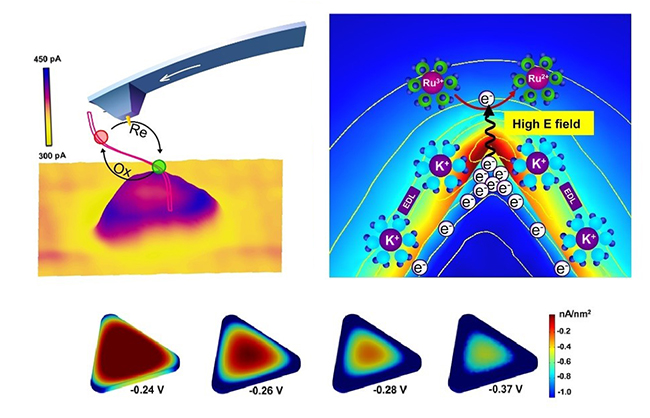The involvement between electron transfer (ET) and catalytic reaction at electrocatalyst surface makes electrochemical process challenging to understand and control. How to experimentally determine ET process occurred at nanoscale is important to understand the overall electrochemical reaction process at active sites.
Recently, a research group led by Prof. LI Can and Prof. FAN Fengtao from the Dalian Institute of Chemical Physics (DICP) of the Chinese Academy of Sciences (CAS) captured the ET image in electrocatalysis process.
This study was published in Nano Letters on Oct. 14.

Electron transfer current followed the trend: corner> edge> basal plane, driven by the interfacial inner potential differences (Imaged by NIE Wei and FAN Fengtao)
The researchers clearly captured the image of ET dominated by mass transport effect at corner and edge sites bounded by {111} facets on single Au triangular nanoplates. They found that ET rate constant of corner sites on Au nanoplate was about twofold that of basal {111} plane.
Furthermore, they found the linear correlation between the logarithm of rate constants and the potential differences of different sites, which demonstrated that spatial heterogeneity of local inner potential differences of Au nanoplates/solution interfaces plays a key role in the ET process.
"We establish the operando AFM/SKPM/SECM instrumental methodology with nanometer-scale spatial resolution, and reveal the quantitative correlation between the inner potential and the kinetic rate by separating the interference of mass transfer from the interfacial electron transfer," said Prof. LI.
"This is a new milestone of the scanning electrochemical probe techniques, making it possible to discover the structure-performance relation of nanocatalyst from the bottom of physical and chemical principles," commented by one of the reviewers.
This work was conducted by the Fundamental Research Center of Artificial Photosynthesis. And it was supported by National Natural Science Foundation of China, CAS Projects for Young Scientists in Basic research, and Interdisciplinary Innovation Team. (Text by NIE Wei and FAN Fengtao)